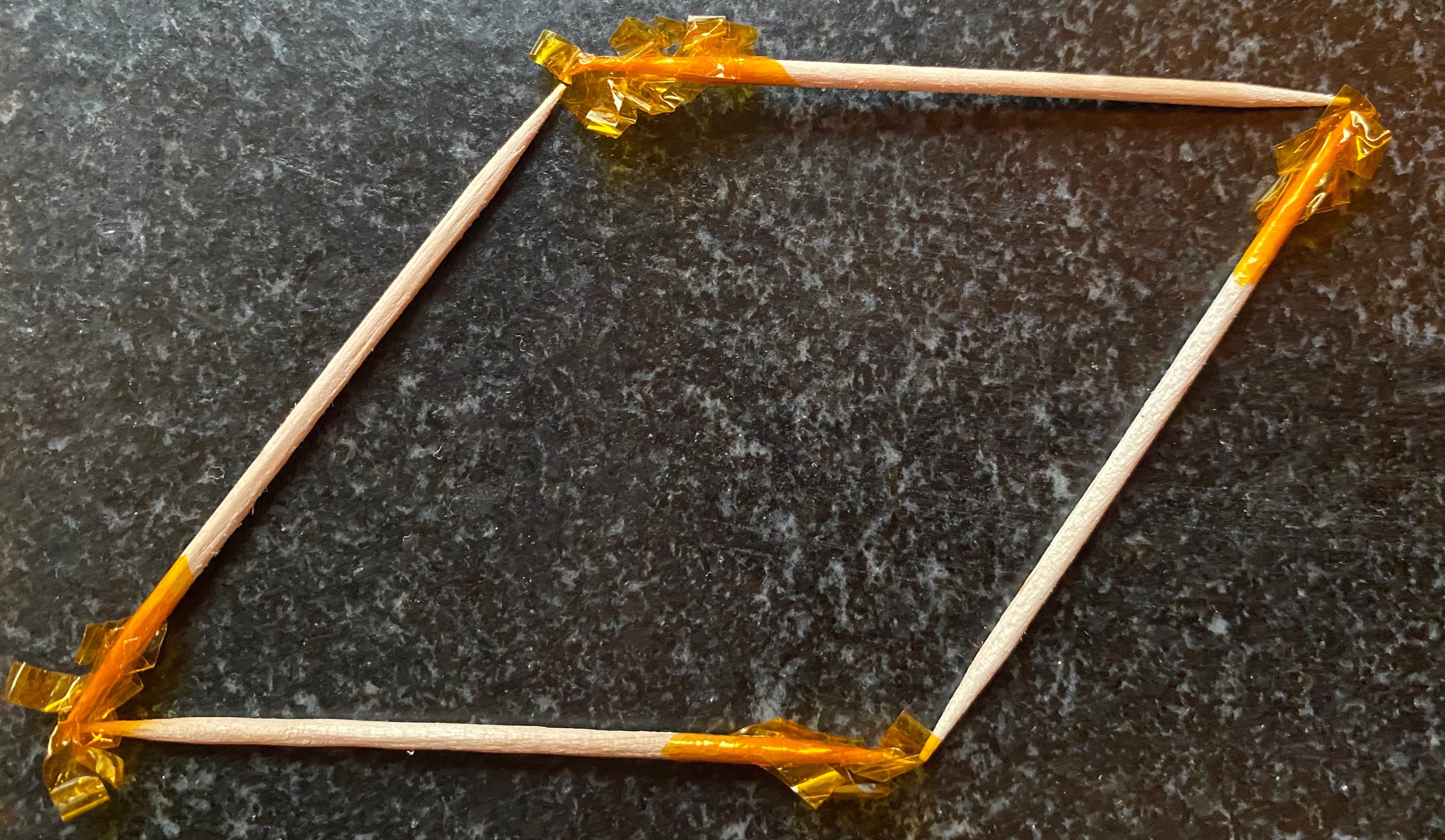Lesson 6
Hierarchy of Quadrilaterals
Warm-up: Notice and Wonder: Squares and Rhombuses (10 minutes)
Narrative
The purpose of this Notice and Wonder is to consider examples of some of the shapes that students will build and study in this lesson, namely squares and rhombuses. The key attributes students may notice in the shapes are the side lengths and the angles.
Launch
- Groups of 2
- Display the image.
- “What do you notice? What do you wonder?”
- 1 minute: quiet think time
Activity
- “Discuss your thinking with your partner.”
- 1 minute: partner discussion
- Share and record responses.
Student Facing
What do you notice? What do you wonder?

Student Response
For access, consult one of our IM Certified Partners.
Activity Synthesis
- “How are these shapes the same? How are they different?” (They have the same side lengths, but the angle measurements are different. The square or the one on the left has all 90 degree angles, but the shape on the right does not have any 90 degree angles.)
- “What names can we use to describe each of the shapes?” (square, rectangle, rhombus, or parallelogram for the one on the left, and rhombus or parallelogram for the one on the right)
Activity 1: Shapes with Toothpicks (15 minutes)
Narrative
Required Materials
Materials to Gather
Required Preparation
- Each group of 2 needs 6 toothpicks.
Launch
- Groups of 2
Activity
- 5 minutes: independent work time.
- 5 minutes: partner work time
- Monitor for students who:
- explain that the square and rhombus have the same side lengths, but different angles
- explain that the rectangle and parallelogram have the same side lengths, but different angles
Student Facing
-
Build a square with your toothpicks. How do you know it is a square?
-
Use the same four toothpicks to build this shape. What stayed the same? What changed?

- Build a rectangle with six toothpicks. How do you know it is a rectangle?
-
Use the same six toothpicks to build this shape. What stayed the same? What changed?

Student Response
For access, consult one of our IM Certified Partners.
Activity Synthesis
- Ask previously selected students to share their thinking.
- “Which of the shapes you made are parallelograms? How do you know?” (They are all parallelograms. The opposite sides are parallel in all of these shapes.)
- “Which of the shapes you built have 4 equal sides?” (The first two, the ones using 4 toothpicks.)
- Display: rhombus
-
“A quadrilateral with 4 equal sides is a rhombus.”
Activity 2: Three Quadrilaterals (20 minutes)
Narrative
The purpose of this activity is for students to determine if quadrilaterals are squares, rhombuses, rectangles, or parallelograms. Then they begin to outline the relationships between these different types of quadrilaterals, leading to the overall hierarchy of quadrilateral types which students investigate more fully in the next lesson.
When students draw quadrilaterals belonging or not belonging to different categories they reason abstractly and quantitively (MP2), using the definitions of the shapes to inform their drawings.
This activity uses MLR3 Clarify, Critique, and Correct. Advances: Reading, Writing, Representing.
Supports accessibility for: Conceptual Processing, Visual-Spatial Processing
Launch
- Groups of 2
Activity
- 5 minutes: independent work time
- 5 minutes: partner work time
Student Facing
-
Draw 3 different quadrilaterals on the grid, making sure at least one of them is a parallelogram.
- For each of your quadrilaterals determine if it is a:
- square
- rhombus
- rectangle
- parallelogram
- Draw a rhombus that is not a square. Explain or show how you know it is a rhombus but not a square.
- Draw a rhombus that is a square. Explain or show how you know it is a rhombus and a square.
- Diego says that it is impossible to draw a square that is not a rhombus. Do you agree with him? Explain or show your reasoning.
Student Response
For access, consult one of our IM Certified Partners.
Activity Synthesis
MLR3 Clarify, Critique, Correct
- Display the following partially correct answer and explanation:
- “Mai says: All squares are rhombuses. If a shape is a square, it is also a rhombus. Rhombuses are not squares.”
- Read the explanation aloud.
- “What do you think Mai means? Is anything unclear?”
- 1 minute: quiet think time
- 2 minutes: partner discussion
- “With your partner, work together to write a revised explanation.”
- Display and review the following criteria:
- Specific words and phrases: all, some
- Labeled table/graph/diagram
- 3–5 minutes: partner work time
- Select 1–2 groups to share their revised explanation with the class. Record responses as students share.
- “What is the same and different about the explanations?” (They all explain why a rhombus does not have to be a square.)
- Display or draw a diagram like this:
- “How can we use this diagram to help us revise Mai’s thinking?” (The diagram shows that all squares are rhombuses but not all rhombuses are squares.)
Lesson Synthesis
Lesson Synthesis
“Today we related squares to rhombuses and rectangles to parallelograms.”
“What makes a square a rhombus?” (It has 4 equal sides.)
“Are all rhombuses squares?” (No, there are rhombuses that have no right angles and they are not squares.)
Display or draw a diagram like this or use the diagram from a previous lesson.

“Where would we draw a rhombus that is not a square?” (In the rhombus box, but not the square box.)
“How does this diagram show that a square is a rhombus and a parallelogram?” (It shows the squares inside the rhombuses that are inside the parallelograms, which means that a shape that is a square is also a rhombus and a parallelogram.)
Cool-down: Rhombuses as Parallelograms (5 minutes)
Cool-Down
For access, consult one of our IM Certified Partners.

